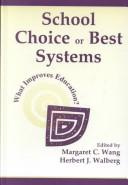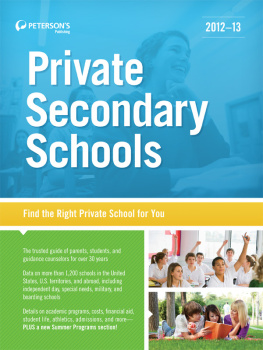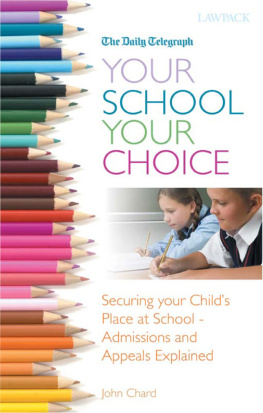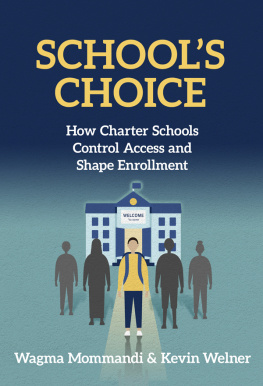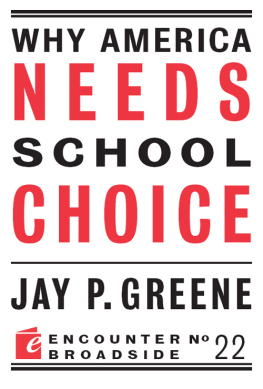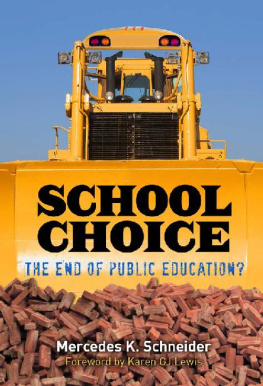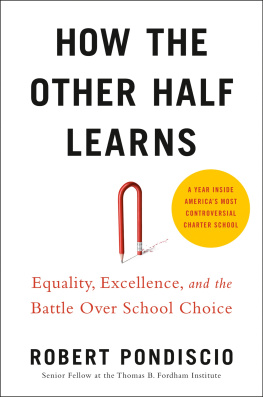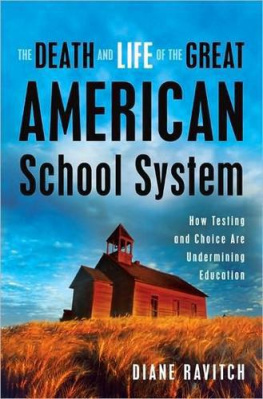Table of Contents

Copyright 2007 by Cato Institute. All rights reserved.
Library of Congress Cataloging-in-Publication Data
Walberg, Herbert J., 1937-
School choice : the findings / Herbert J. Walberg. p. cm.
Includes bibliographical references and index.
ISBN 978-1-933995-05-2 (hardback : alk. paper)ISBN 978-1-933995-04-5 (pbk. : alk. paper)
eISBN : 97-8-193-39953-8
1. School choiceUnited StatesEvaluation. 2. Academic achievementUnited StatesEvaluation. I. Title.
LB1027.9.W34 2007 379.1110973dc22 2007025454
Cover design by Jon Meyers.
Printed in the United States of America.
CATO INSTITUTE
1000 Massachusetts Ave., N.W.
Washington, D.C. 20001
www.cato.org
Acknowledgments
I am fortunate to have been stimulated and supported by colleagues and organizations starting in graduate school at the University of Chicago, where I completed doctoral studies in 1964. The university supported interdisciplinary study, emphasized quantitative analysis, and encouraged doubt about conventional viewsall of which were useful in completing the present book.
My present academic appointment at Stanford Universitys Hoover Institution enabled me, as a member of the Koret Task Force on K-12 Education, to meet twice a year and collaborate with its distinguished membersJohn Chubb, Williamson Evers, Chester Finn, Eric Hanushek, Paul Hill, E. D. Hirsch, Caroline Hoxby, Terry Moe, Paul Peterson, and Diane Ravitch. The members of this group hardly agree on all points about choice and other matters, but we probably would agree that our group discussions are among the most stimulating of our careers. They have led to the founding of the journal Education Next, the publication of a number of books, and evaluations of school policy in Florida, Texas, and Arkansas. I also acknowledge and thank Hoover director John Raisian, who sponsored work on one of my previous books on choice, Education and Capitalism , coauthored with Joseph Bast and published by Hoover Institution Press.
The National Center on School Choice at Vanderbilt University, sponsored by the U.S. Department of Education, has stimulated my thinking and writing about choice. My work there, including that on the Handbook of Research on School Choice and Charter School Outcomes , both coedited with the centers director Mark Berends and associates Dale Ballou and Matthew Springer as the beginning of a new series of books on school choice, has informed and motivated me in writing the present book.
I am honored to be a trustee, and to be stimulated by the other trustees, of the Foundation for Teaching Economics, which provides scholarships for high school teachers and students to study economics. Until his death, the foundation was advised by Milton Friedman, perhaps the most important school choice leader of modern times. At present it includes as board members two Nobel laureates, Douglass North and Vernon Smith, as well as chairman William Hume, president Gary Walton, and other leading academic and business leaders.
Finally, I thank five people who carefully reviewed and made constructive substantive suggestions: Joseph Bast, president of the Heartland Institute, whose board I chair; my friend Steven Graubart; Robin LaSota of the Academic Development Institute; the Cato Institutes Andrew Coulson; and an anonymous reviewer, all of whom informed me about relevant research that had escaped my attention. Perhaps needless to say, the remaining opinions, errors, and infelicities are solely my own.
Herbert J. Walberg Chicago, IL
1. Introduction and Overview
U.S. Schools Are Falling Behind
The United States of America is arguably the world leader in income, wealth, military power, and cultural influence. It hovers near the top of international rankings in higher education, scientific and medical discoveries, and the productivity of many of its industries. Yet U.S. schools are behind those of most other economically advanced countries in both effectiveness and efficiency. By the end of high school, U.S. academic achievement lags behind that of most member countries of the Organization for Economic Cooperation and Developmenta group that includes most of the worlds economically advanced countries.
In addition to being ineffective, American public schools are inefficient or unproductive, which is to say they get little return on taxpayers dollars. Their per student costs rank among the top two or three countries in recent OECD surveys and have risen substantially over the last few decades. This pattern of low and declining efficiency is at odds with most other American enterprises, in which competition has generally led to improved quality and declining (inflation-adjusted) costs.
By widely accepted standards of what educated citizens should know, U.S. students perform poorly in civics, geography, history, and other subjects. Compared to students in other countries, older American students do poorly in mathematics, science, and foreign languages. Yet American students are not behind in the earliest years of schooling. Their achievement, relative to students in other countries, declines during the years when learning is chiefly the responsibility of schools. Indeed, the value-added gains in reading, mathematics, and science for American students are generally among the worst of students living in affluent countries. These findings are becoming better known to the public, parents, and legislators.
The latest available data indicate that the percentage of schools in need of improvement under the generally low standards imposed by states and the federal No Child Left Behind Act of 2002 has increased from 13 percent to 17 percent. They and sharply increasing numbers of other schools face escalating sanctions, such as having to inform parents that their children are in failing schools, being required to allow parents to transfer their children to successful schools, replacing staff, and, if failure continues, possible closure.
Despite such present and prospective sanctions, despite widespread recognition of the achievement problem, despite higher school spending, the National Assessment of Educational Progress (referred to as the nations report card) reported in February 2007 that reading achievement of American 12th grade students had declined from 1992 through 2005. Standards, instead of rising, have declined; despite the drop in students performance, teachers are giving them higher grades.
Poor high school performance leads to poor college performance. According to the National Center for Public Policy and Higher Education, only 68 percent of ninth graders graduate on time; only 40 percent enroll directly in college.
Because of poor prior preparation in high school, college graduates perform poorly: This past August [2006], the National Commission on the Future of Higher Education reported that the quality of student learningas measured by assessments of college graduatesis declining. It cited a stunning finding of the National Assessment of Adult Literacy: Only 31 percent of college-educated Americans qualify as prose literate, meaning that at they can fully comprehend something as simple as a newspaper story. This number has shrunk from 40 percent a decade ago, apparently because the flood of badly educated new graduates is dragging down the average.
In addition to being ineffective and inefficient, schools can be dangerous places, particularly those in big cities and those serving predominantly poor and minority students. In a recent poll, 73 percent of low-income parents and 46 percent of higher-income parents said they worried a lot about their childrens exposure to drugs and alcohol at school. Similarly, 65 percent of low-income parents and 39 percent of higher-income parents worried a great deal about their children being assaulted or even kidnapped.
Next page
